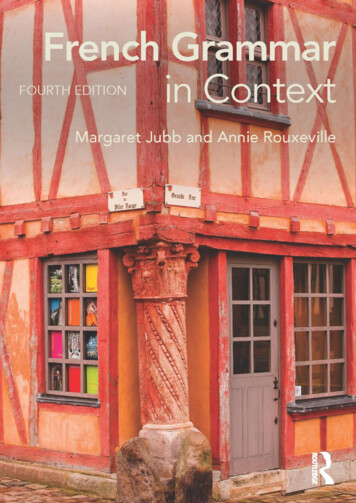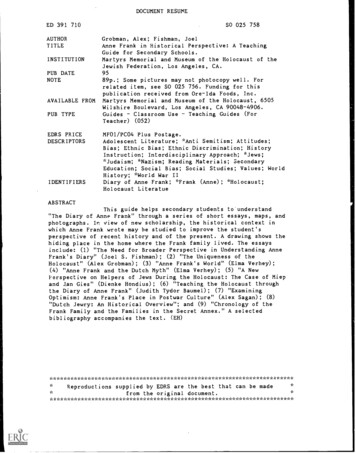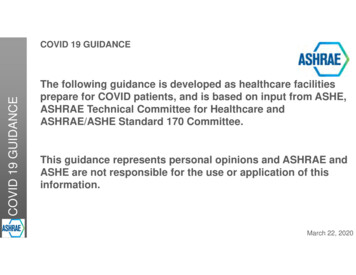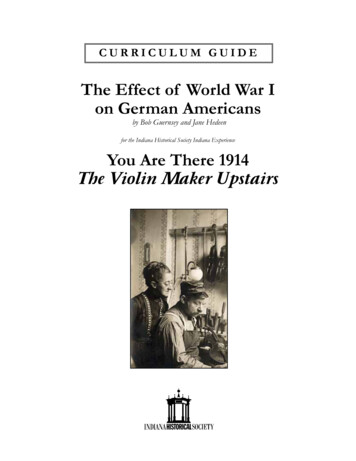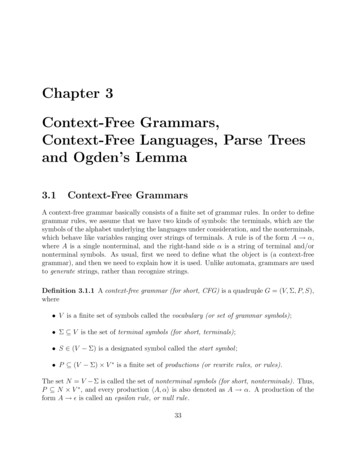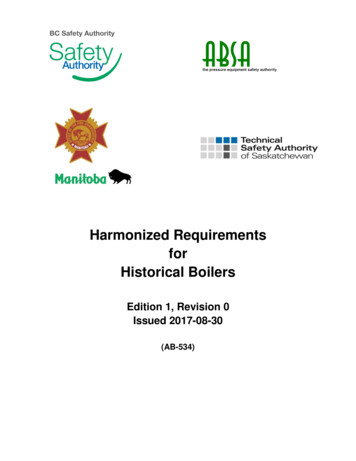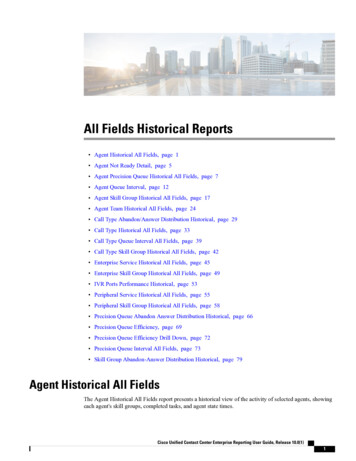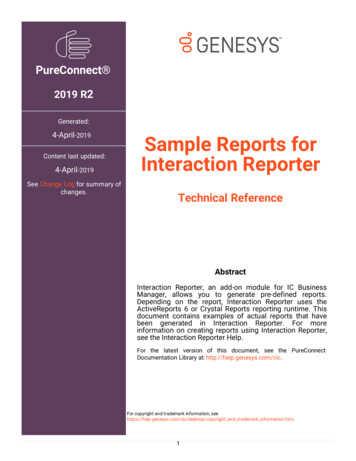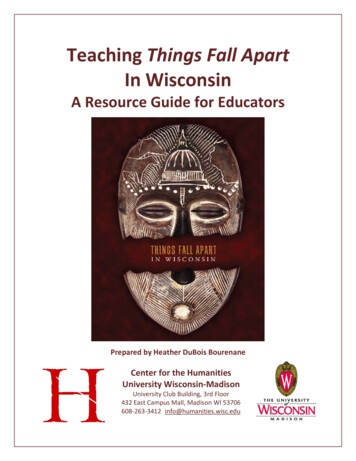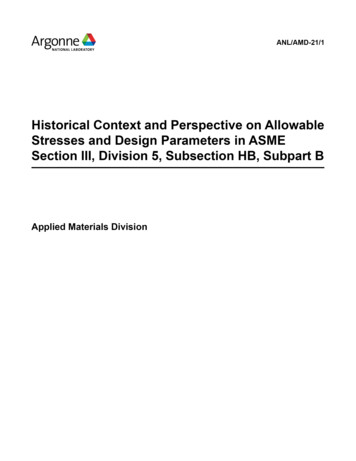
Transcription
ANL/AMD-21/1Historical Context and Perspective on AllowableStresses and Design Parameters in ASMESection III, Division 5, Subsection HB, Subpart BbyTing-Leung Sham 1Applied Materials Division, Argonne National LaboratoryMarch 20211Current affiliation: Idaho National Laboratory
CONTENTSCONTENTS. iiiFIGURES . ivTABLESviACRONYMS AND ABBREVIATIONS . viiiACKNOWLEDGMENTS . ixEXECUTIVE SUMMARY .x1 INTRODUCTION .12 SECTION III, DIVISION 5 .32.1GENERAL CONSERVATISM IN THE DESIGN PROCEDURE IN SECTIONIII, DIVISION 5 FOR CLASS A COMPONENTS .42.1.1 Primary, load-controlled stress limits .42.1.2 Displacement-controlled limits .62.1.3 Creep-fatigue.62.2 CONSERVATISMS INHERENT IN DETERMINING THE MATERIALSPROPERTIES AND ALLOWABLE STRESSES FOR SECTION III,DIVISION 5 CLASS A COMPONENTS .82.3 CONSERVATISM IN THE WELDMENT DESIGN PROCEDURE IN SECTIONIII, DIVISION 5 FOR CLASS A COMPONENTS .92.3.1 Perspective on weldment evaluation procedures .103 CRITERIA FOR ALLOWABLE STRESSES AND DESIGN PARAMETERS .113.1 ALLOWABLE STRESS INTENSITIES .113.1.1 Base materials .113.1.2 Weldments .123.2 YIELD STRENGTH AND TENSILE STRENGTH .133.2.1 Aging factors.134 ASSESSMENT OF HBB ALLOWABLE STRESSES AND DESIGN PARAMETERS ANDNRC CONTRACTOR COMMENTS .144.1EXPECTED MINIMUM STRESS-TO-RUPTURE 𝑺𝑺𝑺𝑺 AND ALLOWABLESTRESS INTENSITY 𝑺𝑺𝑺𝑺 .154.1.1 304H and 316H stainless steels.154.1.2 Alloy 800H.214.1.3 2.25Cr-1Mo steel (Grade 22 Class 1, annealed) .234.1.4 9Cr-1Mo-V steel (Grade 91).274.2 ALLOWABLE STRESS INTENSITY 𝑺𝑺𝟎𝟎 FOR DESIGN LOADINGS.274.2.1 304H stainless steel .274.2.2 316H stainless steel .284.2.3 Alloy 800H.294.2.4 2.25Cr-1Mo steel (Grade 22, Class 1, annealed) .294.2.5 9Cr-1Mo-V steel (Grade 91).304.2.6 Discussion .31iii
4.3 AGING FACTORS .324.3.1 Alloy 800H.324.3.2 2.25Cr-1Mo steel (Grade 22, Class 1, annealed) .344.3.3 9Cr-1Mo-V steel (Grade 91).355 STRESS RUPTURE FACTOR, R .375.1 DATA SOURCES .375.2 TYPE 304 WELDS .395.2.1 308 filler materials .395.2.2 16-8-2 filler material .395.2.3 316 filler material.405.3 TYPE 316 WELDS .405.3.1 308 filler materials .405.3.2 16-8-2 filler material .415.3.3 316 filler material.415.4 ALLOY 800H WELDS .425.4.1 Alloy A filler material.425.4.2 Alloy 82 filler material.425.5 2.25Cr-1Mo WELDS .435.6 9Cr-1Mo-V STEEL (GRADE 91) WELDS .505.6.1 Summary on 9Cr-1Mo-V stress rupture factors.555.7 ALLOY 617 WELDS .555.7.1 ERNiCrCoMo-1 filler material .555.8 SUMMARY COMMENTARY ON WELDS .556 ASSESSMENT OF OTHER NRC CONTRACTOR COMMENTS.576.1 ISOCHRONOUS STRESS STRAIN CURVES, 9Cr-2Mo-V .596.1.1 Perspective on HBB design procedures to account for scatter in materialdeformation data .596.1.2 Average properties for ISSCs .626.1.3 Large scatter in the flow strength and creep deformation data .637 References .65FIGURESFIGURE 1 Section III, Division 5 Organization. .3FIGURE 2 Expected minimum stress-to-rupture for 304H, data from STP-NU-063 [7]. .18FIGURE 3 Expected minimum stress-to-rupture for 316H, data from STP-NU-063 [7]. .19FIGURE 4 Comparison of average values from SRS and Larson-Miller analysis with the sevenheats of NIMS 2.25Cr-1Mo tubing data, following Swindeman [14]. .25FIGURE 5 Effects of thermal aging (in air) on the strength of Alloy 800H at room temperatureand at the aging temperature, after Trester et al. [15]. The shaded region shows thetemperature range where the HBB aging factors are 0.9. .33iv
FIGURE 6 Comparison of measured yield strength after aging with the calculated strength usingthe HBB code procedure for 2.25Cr-1Mo. .34FIGURE 7 Comparison of measured tensile strength after aging with the calculated strengthusing the HBB code procedure for 2.25Cr-1Mo. .35FIGURE 8 Comparison of measured creep rupture data against HBB prediction for Type 304stainless with 308 filler material. .39FIGURE 9 Comparison of measured creep rupture data against HBB prediction for Type 304stainless with 16-8-2 filler material. .39FIGURE 10 Comparison of measured creep rupture data against HBB prediction for Type 304stainless with 316 filler material. .40FIGURE 11 Comparison of measured creep rupture data against HBB prediction for Type 316stainless with 308 filler material. .40FIGURE 12 Comparison of measured creep rupture data against HBB prediction for Type 316stainless with 16-8-2 filler material. .41FIGURE 13 Comparison of measured creep rupture data against HBB prediction for Type 316stainless with 316 filler material. .41FIGURE 14 Comparison of measured creep rupture data against HBB prediction for Alloy 800Hwith Alloy A filler material.42FIGURE 15 Comparison of measured creep rupture data against HBB prediction for Alloy 800Hwith Alloy 82 filler material. .42FIGURE 16 Qualitative comparisons of 2.25Cr-1Mo weld data with HBB design values.Quantitative comparisons can be found in the EPRI report prepared by R.W. Warke [22]. .50FIGURE 17 Comparison of measured creep rupture data against 𝑹𝑹𝑹𝑹𝑹𝑹𝑹𝑹𝑹𝑹 𝑺𝑺𝑺𝑺𝑺𝑺𝑺𝑺𝑺𝑺𝟕𝟕 for 9Cr1Mo-V. .51FIGURE 18 Comparison of measured creep rupture data against 𝑹𝑹𝑹𝑹𝑹𝑹𝑹𝑹𝑹𝑹 𝑺𝑺𝑺𝑺𝑺𝑺𝑺𝑺𝑺𝑺𝑺𝑺 for 9Cr1Mo-V. .52FIGURE 19 Comparison of measured creep rupture data against 𝑹𝑹𝑹𝑹𝑹𝑹 𝟐𝟐𝟐𝟐𝟐𝟐𝟐𝟐 𝑺𝑺𝑺𝑺𝑺𝑺𝑺𝑺𝑺𝑺𝑺𝑺 for9Cr-1Mo-V. .52FIGURE 20 Comparison of measured creep rupture data against HBB prediction for Alloy 617with ERNiCrCoMo-1 filler material. .55FIGURE 21 Comparison between the stress relaxation profile produced by the design-byelastic-analysis ISSC method to the profile produced by integrating the creep modelunderlying the 2017 edition ISSCs through the stress relaxation condition. This example usesan initial stress of 310 MPa (0.5 strain according to the 2017 edition hot tensile curves), atemperature of 550 C, and a hold time of 1000 hours. .61FIGURE 22 Yield stress comparison between experimental data, the 2017 edition HBB hottensile curves, and the STP-PT-080 hot tensile curves. .63FIGURE 23 Comparison between a set of experimental creep curves at 550 C and 240 MPaload and the predicted creep curves using the models underlying the 2017 edition HBB andSTP-PT-080 ISSCs. .64v
FIGURE 24 Comparison of Grade 91 minimum strain rate data from U.S. and Japan withpredictions from strain equation for the 2017 ISSCs. .64TABLESTABLE 1 𝑺𝑺𝑺𝑺 intensities for 304H based on the more accurate treatment of the tertiary creepcriterion by Dabrow and Nestell [10], 𝑺𝑺𝑺𝑺 in MPa .17TABLE 2 𝑺𝑺𝑺𝑺 intensities for 316H based on the more accurate treatment of tertiary creepcriterion by Dabrow and Nestell [10], 𝑺𝑺𝑺𝑺 in MPa .18TABLE 3 304H, difference in 𝑺𝑺𝑺𝑺 between 2017 code and Dabrow-Nestell [10] values, 𝑫𝑫𝑫𝑫, % .19TABLE 4 304H, difference in 𝑺𝑺𝑺𝑺 between 2017 code and STP-NU-063 values, 𝑫𝑫𝑫𝑫, % .20TABLE 5 316H, difference in 𝑺𝑺𝑺𝑺 between 2017 code and Dabrow-Nestell [10] values, 𝑫𝑫𝑫𝑫, % .20TABLE 6 316H, difference in 𝑺𝑺𝑺𝑺 between 2017 code and STP-NU-063 values, 𝑫𝑫𝑫𝑫, % .20TABLE 7 𝟎𝟎. 𝟔𝟔𝟔𝟔 𝑺𝑺𝑺𝑺 for Alloy 800H from the 2017 code edition, 𝟎𝟎. 𝟔𝟔𝟔𝟔 𝑺𝑺𝑺𝑺, in MPa.22TABLE 8 𝑺𝑺𝑺𝑺 values of Alloy 800H from 2017 code edition 𝑺𝑺𝑺𝑺, in MPa .22TABLE 9 𝑫𝑫𝑫𝑫 values for Alloy 800H 𝑫𝑫𝑫𝑫, % .23TABLE 10 Comparison of 𝑺𝑺𝑺𝑺 at 100,000 hours from SRS analysis and HBB for 2.25Cr-1Mo .26TABLE 11 Comparison of 𝟎𝟎. 𝟔𝟔𝟔𝟔 𝑺𝑺𝑺𝑺 and 𝑺𝑺𝑺𝑺 at 100,000 hours from the respective SRS analysisand HBB for 2.25Cr-1Mo .26TABLE 12 Comparison of 𝑺𝑺, 𝑺𝑺𝑺𝑺𝑺𝑺 at 300k hours, and 𝑺𝑺𝑺𝑺 values for 304H .27TABLE 13 Comparison of 𝑺𝑺, 𝑺𝑺𝑺𝑺𝑺𝑺 at 300k hours and 𝑺𝑺𝑺𝑺 values for 316H .28TABLE 14 Comparison of 𝑺𝑺, 𝑺𝑺𝑺𝑺𝑺𝑺 at 300k hours, and 𝑺𝑺𝑺𝑺 values for Alloy 800H .29TABLE 15 Comparison of 𝑺𝑺, 𝑺𝑺𝑺𝑺𝑺𝑺 at 300k hours and 𝑺𝑺𝑺𝑺 values for 2.25Cr-1Mo (annealed) .30TABLE 16 Comparison of 𝑺𝑺, 𝑺𝑺𝑺𝑺𝑺𝑺 at 300k hours and 𝑺𝑺𝑺𝑺 values of 9Cr-1Mo-V in 2017 and2019 code edition .31TABLE 17 Tensile strength aging factors from 2017 edition and RC 19-411, respectively, for9Cr-1Mo-V .36TABLE 18 Values of rupture stress for weldment determined from 𝑹𝑹𝟐𝟐𝟐𝟐𝟐𝟐𝟐𝟐 𝑺𝑺𝑺𝑺𝟐𝟐𝟐𝟐𝟐𝟐𝟐𝟐, MPa .53TABLE 19 Values of rupture stress for weldment determined from 𝑹𝑹𝑹𝑹𝑹𝑹𝑹𝑹𝑹𝑹 𝑺𝑺𝑺𝑺𝑺𝑺𝑺𝑺𝑺𝑺𝑺𝑺, MPa .53TABLE 20 Values of rupture stress for weldment determined from 𝑹𝑹𝑹𝑹𝑹𝑹 𝟐𝟐𝟐𝟐𝟐𝟐𝟐𝟐 Pa 54TABLE 21 Percentage difference, 𝑫𝑫𝑫𝑫, between the old and new 𝑹𝑹 factors for 9Cr-1Mo-V,𝑫𝑫𝑫𝑫,% .54vi
TABLE 22 Margin in creep damage fraction between the ISSC relaxation analysis used in theSection III, Division 5 design-by-elastic-analysis creep damage calculation option and anexact integration of the creep equations through the stress relaxation condition. .61vii
ACRONYMS AND ABBREVIATIONSASMEAmerican Society of Mechanical EngineersBPVCBoiler and Pressure Vessel CodeC&SCRBRCodes and StandardsClinch River Breeder ReactorDOEDepartment of EnergyEPRIElectric Power Research InstituteGMAGTAGas Metal ArcGas-Tungsten ArcHBBHTGRSubsection HB, Subpart BHigh Temperature Gas-Cooled ReactorISSCIsochronous Stress Strain CurveLWRLight Water ReactorMCMMinimum Commitment MethodNGNPNIMSNQANRCNRRNext Generation Nuclear PlantNational Institute for Materials ScienceNuclear Quality AssuranceNuclear Regulatory CommissionNuclear Reactor RegulationORNLOak Ridge National LaboratoryRGRegulatory GuideSASMASRSSubmerged ArcShielded Metal ArcStress Range SplittingTWGTechnology Working GroupUTSUltimate Tensile Strengthviii
ACKNOWLEDGMENTSThis report was sponsored by the U.S. Nuclear Regulatory Commission (NRC), Office ofNuclear Reactor Regulation (NRR) under NRC Agreement Number 31310019N0003 and TaskOrder Number 31310020F0026. The author would like to thank Ms. Maryam Khan, NRCContracting Officer’s Representative, Mr. Jordan Hoellman, Mr. Jeffrey Poehler, and severalother NRC staff members for their helpful feedback.Helpful discussions with Robert Jetter, Mark Messner, Robert Swindeman, Yanli Wang,and Richard Wright are gratefully acknowledged.The author would also like to acknowledge the assistance by Mr. Bruce Biwer, the EWAProgram Manager at the Argonne National Laboratory.ix
EXECUTIVE SUMMARYThe U.S. Nuclear Regulatory Commission (NRC) is reviewing the 2017 edition of theAmerican Society of Mechanical Engineers (ASME) Boiler and Pressure Vessel Code (BPVC)Section III, Division 5 for endorsement. This supports part of the NRC Implementation ActionPlan under Strategy 4: Facilitate industry code and standards development needed to support thenon-light water reactor (LWR) lifecycle, including fuels and materials. The NRC review ofSection III, Division 5 will emphasize the “Reasonable Assurance of Adequate Protection”standard. The NRC review team consists of materials, mechanical, and inspection staff from theOffice of Nuclear Reactor Regulation (NRR), NRC Region II (RII), and the Office of NuclearRegulatory Research (RES). In October 2018, the NRC core team sent the ASME BPVC SectionIII, Division 5 standard and the technical background documents to Pacific Northwest NationalLaboratory (PNNL), Oak Ridge National Laboratory (ORNL), and NUMARK Associates, Inc.for a peer review on the technical adequacy of Section III, Division 5.In January 2020, the NRC initiated efforts to review the PNNL, ORNL, and NUMARKreports and to begin drafting the Regulatory Guide (RG) and the supporting technical basisdocument, the NUREG. NRC has contracted Argonne National Laboratory (ANL) to provide theNRC review team with the technical basis and historical perspective on ASME BPVC SectionIII, Division 5 and the technical assistance to facilitate the staff’s efforts in drafting the RG andthe NUREG.Elevated-temperature design rules for nuclear components were initiated in 1963 withASME Code Case 1331. Complete construction rules for elevated-temperature pressureboundary metallic components under cyclic service were first published in the early 1970s in aseries of ASME Code Cases (1592 through 1596). These Code Cases were referenced by NRC inRG 1.87, Rev 1, June 1975, to provide interim licensing guidelines to aid applicants inimplementing the 10 CFR Part 50 requirements with respect to ASME BPVC Class 1components operating at elevated temperatures for high-temperature gas-cooled reactors, liquidmetal fast-breeder reactors, and gas-cooled fast-breeder reactors.These rules have undergone continued development and improvement as the 159x seriesof Code Cases evolved into the current Section III, Division 5, Subsection HB, Subpart B(HBB). For example, the weldment design guidance was quite minimal in the early stage ofBPVC development. In response to the NRC concern about weldment cracking during theevaluation of the Clinch River Breeder Reactor Plant, weldment design procedures wereintroduced to improve the overall high-temperature design methodology for welded construction.In addition to primary load design, the HBB rules for cyclic loading also address loss of ductilityand creep-fatigue failure in weldment. The latter are unique to the HBB rules within the ASMEBPVC.Similar to Section III, Division 1, Subsection NB rules for LWR construction, the HBBrules are based on the identification of, and protection against, structural failure modes. Inaddition to those for low-temperature cyclic service, structural failure modes for elevatedtemperature cyclic service are further emphasized in HBB. Design rules and supportingx
allowable stresses and design parameters for specific construction materials were developed toguard against these structural failure modes for the full range of operating temperatures of thepressure boundary components. The material data requirements and criteria for the allowablestresses and design parameters flow from the design evaluation methods for the failure modesand apportionment of design margins relative to the design rules. Thus, assessment of theadequacy of the allowable stresses and design parameters must be fully cognizant of theinterrelationship between the material properties and the elevated-temperature design rules, butnot just the material properties in isolation.Development of the technical basis of the HBB allowable stresses and design parametersis an enormous task. The current allowable stresses and design parameters were establishedthrough many years of development by many ASME volunteers and were approved for code usethrough the Codes and Standards consensus process. This process provided valuable checks andbalances whereby the code intent, use experience, and engineering judgment were renderedabout the impact of the proposed item on the overall adequacy of the HBB construction rules toprovide a reasonable assurance of structural integrity.The materials section and material properties in HBB were reviewed by ORNL for theNRC. Materials data from various sources were first assembled, and the technical basis of theallowable stresses and design parameters were recreated by conducting data analyses on theassembled data. ORNL assessed the adequacy of the HBB allowable stresses and designparameters by comparing them against the recreated technical basis. It is unlikely that the datasupporting the ORNL review and those underlying the values in HBB are identical; thus, itshould be expected that there will be some numerical differences between the two sets ofallowable stresses.In this report, the general conservatism in the HBB design procedures is first discussedwith respect to (i) primary load-controlled stress limits, (ii) displacement-controlled deformationlimits, and (iii) creep-fatigue. This is followed by a discussion about the conservatisms inherentin determining the allowable stresses and design parameters and the conservatism in theweldment design procedure in HBB. The relevant criteria for the allowable stresses and designparameters are then summarized.Assessment of the HBB allowable stresses and design parameters is then conducted. Thisincludes assessment of the weldment design parameters that were not reviewed by ORNL, perNRC request. Instead of recreating the technical basis, code intent, historical code committeeinformation, various publications on code criteria, and background information on code actionswere leveraged in this assessment.The 2017 HBB is the edition of record for the NRC endorsement effort. However,revisions of some of the allowable stresses and design parameters have been made in the 2019edition and the to-be-issued 2021 edition. Further, there are revisions slated for actions in the2023 edition. Thus, in order to render a meaningful assessment, temperature limits on the 2017HBB values judged to provide a reasonable assurance of adequate protection, where applicable,are provided. They can be updated when NRC endorsement of a future code edition is made.Overall, the allowable stresses and design parameters in the 2017 edition of HBB are adequatelyxi
conservative, except for some of the situations in comparison with subsequent code editionsnoted above, and further detailed in the report.Assessment of the ORNL review of the allowable stresses and design parameters is alsoprovided in the report. Critical evaluation of the data assembled by ORNL with respect to theASME material specifications and additional Section III requirements was not conducted in thisreport, nor were the data analyses by ORNL verified, as they are outside the scope of this work.While the ORNL effort in recreating the technical basis of the allowable stresses and designparameters is commendable, it is no substitute for the Codes and Standards review and theconsensus approval process.A significant finding concerning the ORNL review is that, while a considerable effortwent into its preparation, it contains errors such as application of non-code criteria, e.g., thethermal aging criteria; misinterpretation of the code intent, e.g., the design loadings allowablestress criteria; and the selection of non-permissible material, e.g., the inclusion of the normalizedand tempered condition for the 2.25Cr-1Mo steel in the database.Further, assessment of the adequacy of the allowable stresses and design parameters wasperformed without due consideration of the context of the design rules. For example, effort wasexpended on data analysis for the design loading allowable stresses, 𝑆𝑆0 , which are, instead,defined by reference in HBB to the allowable stresses for Section I and Section VIII, Division 1and are used merely as a consistency check and do not control the primary load design. Anotherexample is the use of the expected minimum stress-to-rupture in the context of primary loaddesign where extrapolation to full design life is important versus creep-fatigue evaluations wherecreep damage increments calculated toward the end of a cycle period under high temperature,low stress, and long rupture time conditions generally are negligibly small.The collection of recent data by ORNL is a valuable effort that would be helpful for codeimprovement. However, deficiencies of the ORNL review documented in this report need to berecognized in addressing the adequacy of the allowable stresses and design parameters of HBBto provide a reasonable assurance of adequate protection. Although, with the conservatisms andredundancies in the design procedures as discussed in this report, the allowable stresses anddesign parameters in the 2017 edition of HBB would arguably still lead to a design that providesa “reasonable assurance of adequate protection” for the intended service life.However, to provide a path forward strategy for the NRC Section III, Division 5endorsement effort, the approach herein is to assess limitations on the use of the contested 2017properties, if applicable, that would permit current advanced reactor design activities to proceedpending resolution by all the applicable ASME Code consensus committees. It is noted that someof these updates have already been incorporated in newer editions of HBB.Assessment of the NUMARK review on the isochronous stress-strain curves for9Cr-1Mo-V steel was also conducted, as requested by NRC. Contrary to the recommendation ofNUMARK, it is judged that all the isochronous stress-strain curves in HBB, including9Cr-1Mo-V, are adequate to support conservative creep-fatigue designs, as detailed in thisreport.xii
1 INTRODUCTIONIn the 1970s, the U.S. Nuclear Regulatory Commission (NRC) issued Regulatory Guide(RG) 1.87 (Rev 1, June 1975) to provide interim licensing guidelines to aid applicants inimplementing the 10 CFR Part 50 requirements with respect to American Society of MechanicalEngineers (ASME) Boiler Pressure and Vessel Code (BPVC) Class 1 components operating atelevated temperatures for high-temperature gas-cooled reactors, liquid-metal fast-breederreactors, and gas-cooled fast-breeder reactors. RG 1.87 referenced ASME Code Case 1592 formaterials and design and Code Cases 1593, 1594, 1595, and 1596 for fabrication and installation,examination, testing, and overpressure protection, respectively.When the nuclear code cases were separated from the non-nuclear code cases by ASME,the Code Case 1592 series was converted to Code Case N-47, which was used by the ClinchRiver Breeder Reactor (CRBR) project, with additional U.S. Department of energy (DOE)requirements for the structural design of CRBR. A license application for a construction permitfor CRBR was submitted to the NRC for approval in the late 1970s. Assessment of theconstruction rules of Code Case N-47 was carried out by the NRC. The NRC licensingevaluations were in progress when the Government cancelled the CRBR project; hence, therewas no ruling on the adequacy of the construction rules of Code Case N-47. Continuedimprovements of the rules of N-47 were made, and Code Case N-47 was subsumed into a newSection III, Division 1, Subsection NH by ASME in 1995.In 2007, wording was added to 10 CFR 50.55a to the effect that Subsection NH may onlybe used for the design and construction of Type 316 stainless steel pressurizer heater sleeveswhere service conditions do not cause the component to reach temperatures exceeding 900 F(483 C). That led to uncertainty in the use of Subsection NH by advanced reactor developers fortheir licensing efforts.In the mid-2000s, ASME was requested to develop a new division within Section III toconsolidate all high-temperature construction rules in Subsection NH and other Division 1 codecases, and to add graphite rules to the new division,
American Society of Mechanical Engineers (ASME) Boiler and Pressure Vessel Code (BPVC) Section III, Division 5 for endorsement. This supports part of the NRC Implementation Action Plan under Strategy 4: Facilitate industry code and standards development needed to support the non-light wate

